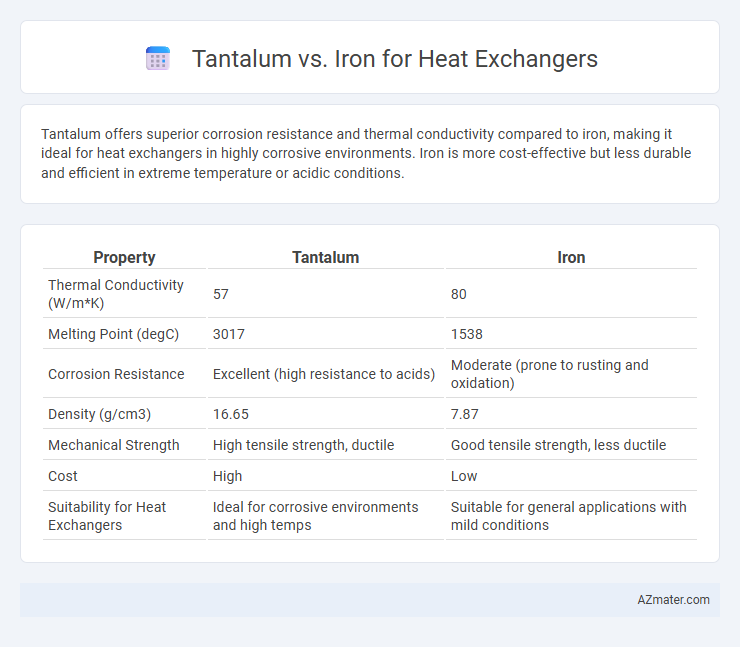Tantalum offers superior corrosion resistance and thermal conductivity compared to iron, making it ideal for heat exchangers in highly corrosive environments. Iron is more cost-effective but less durable and efficient in extreme temperature or acidic conditions.
Table of Comparison
| Property | Tantalum | Iron |
|---|---|---|
| Thermal Conductivity (W/m*K) | 57 | 80 |
| Melting Point (degC) | 3017 | 1538 |
| Corrosion Resistance | Excellent (high resistance to acids) | Moderate (prone to rusting and oxidation) |
| Density (g/cm3) | 16.65 | 7.87 |
| Mechanical Strength | High tensile strength, ductile | Good tensile strength, less ductile |
| Cost | High | Low |
| Suitability for Heat Exchangers | Ideal for corrosive environments and high temps | Suitable for general applications with mild conditions |
Introduction to Heat Exchanger Materials
Tantalum offers exceptional corrosion resistance and high melting point, making it ideal for heat exchangers handling aggressive chemicals and high-temperature environments. Iron, commonly used due to its affordability and mechanical strength, is less resistant to corrosion and high temperatures compared to tantalum, limiting its application in harsh conditions. Selecting the appropriate heat exchanger material depends on balancing factors like thermal conductivity, corrosion resistance, operating temperature, and cost.
Overview of Tantalum and Iron
Tantalum offers exceptional corrosion resistance and high melting point around 3017degC, making it ideal for heat exchangers in chemically aggressive environments. Iron, with a melting point of approximately 1538degC and widespread availability, provides cost-effective thermal conductivity but lacks the corrosion resistance found in tantalum. Selecting between tantalum and iron depends on balancing durability, chemical compatibility, and budget requirements for heat exchanger applications.
Thermal Conductivity: Tantalum vs Iron
Tantalum exhibits a thermal conductivity of approximately 57 W/m*K, significantly lower than iron's thermal conductivity, which ranges between 80 to 90 W/m*K depending on its alloy composition. This difference means iron transfers heat more efficiently, making it preferable for applications requiring rapid heat dissipation in heat exchangers. However, tantalum's superior corrosion resistance can justify its use in specialized heat exchangers despite its lower thermal conductivity.
Corrosion Resistance Comparison
Tantalum exhibits superior corrosion resistance compared to iron, especially in highly acidic environments such as hydrochloric acid or sulfuric acid, where iron is prone to rapid corrosion and pitting. The formation of a stable, protective oxide layer on tantalum enhances its durability and lifespan in aggressive chemical processes, making it ideal for heat exchangers handling corrosive fluids. Iron, while cost-effective and mechanically robust, requires frequent maintenance and protective coatings, limiting its use in highly corrosive heat exchanger applications.
Mechanical Strength and Durability
Tantalum exhibits superior mechanical strength and exceptional corrosion resistance compared to iron, making it highly durable in aggressive heat exchanger environments. Its high melting point and resistance to thermal fatigue allow it to maintain structural integrity under extreme temperatures better than iron. Iron, though more cost-effective, is prone to oxidation and mechanical degradation under prolonged high-temperature exposure, reducing its overall durability in heat exchanger applications.
Cost Analysis: Tantalum vs Iron
Tantalum heat exchangers exhibit superior corrosion resistance and high-temperature stability but come with significantly higher material and fabrication costs compared to iron, which is more economical and widely available. Iron heat exchangers benefit from low raw material prices and established manufacturing processes, making them a cost-effective choice for standard applications, though they may require more frequent maintenance or replacement in aggressive environments. Cost analysis must weigh initial expenditure against long-term durability and maintenance expenses, with tantalum offering better life-cycle value in highly corrosive or high-temperature settings despite its premium upfront cost.
Weight and Density Factors
Tantalum offers significantly higher density at approximately 16.69 g/cm3 compared to iron's 7.87 g/cm3, resulting in heavier heat exchangers when using tantalum. Despite its weight, tantalum's superior corrosion resistance and high melting point make it suitable for extreme environments, whereas iron's lower density contributes to lighter, more cost-effective units. Engineers must balance tantalum's durability with iron's lightweight advantages to optimize heat exchanger performance based on application-specific requirements.
Applications in Heat Exchangers
Tantalum offers exceptional corrosion resistance and high melting points, making it ideal for heat exchangers in aggressive chemical environments such as those found in the chemical processing and pharmaceutical industries. Iron, particularly in the form of carbon steel or stainless steel, is widely used for heat exchangers due to its cost-effectiveness and good thermal conductivity but is susceptible to corrosion in highly acidic or alkali conditions. In applications where durability and resistance to harsh media are critical, tantalum heat exchangers outperform iron by maintaining structural integrity and heat transfer efficiency over extended periods.
Environmental and Safety Considerations
Tantalum offers superior corrosion resistance compared to iron, reducing the risk of environmental contamination from metal leaching in heat exchangers operating under aggressive conditions. Its high chemical stability minimizes hazardous waste generation during maintenance, enhancing overall environmental safety. Iron's susceptibility to corrosion can lead to leaks and the release of potentially harmful substances, posing higher risks to both environmental and operational safety.
Selecting the Best Material for Your Heat Exchanger
Tantalum offers superior corrosion resistance and excellent thermal conductivity, making it ideal for heat exchangers in highly corrosive environments such as chemical processing plants. Iron, while more cost-effective and widely available, lacks the corrosion resistance required for aggressive fluids, limiting its use to less demanding applications with moderate thermal requirements. Selecting the best material depends on factors like operating temperature, fluid corrosiveness, maintenance costs, and budget constraints to ensure durability and efficiency.

Infographic: Tantalum vs Iron for Heat Exchanger
 azmater.com
azmater.com